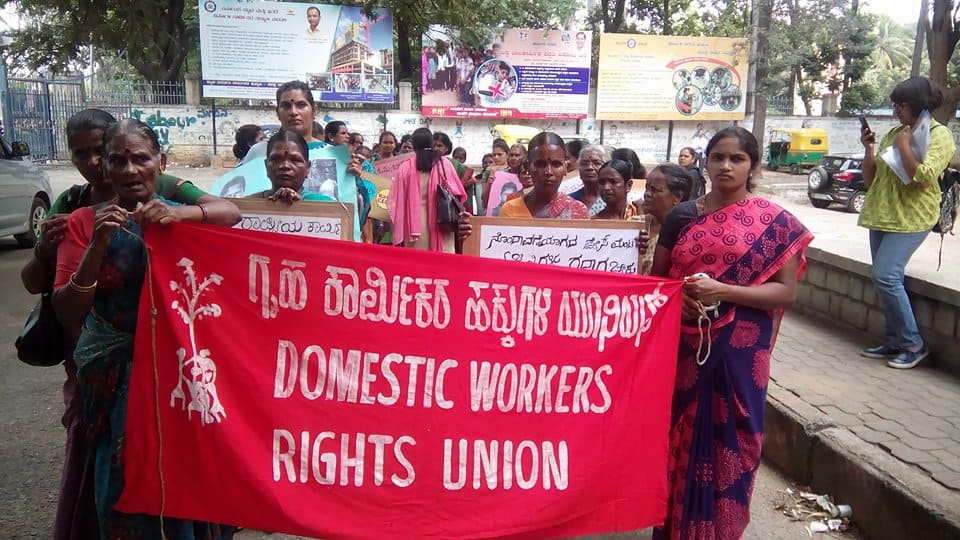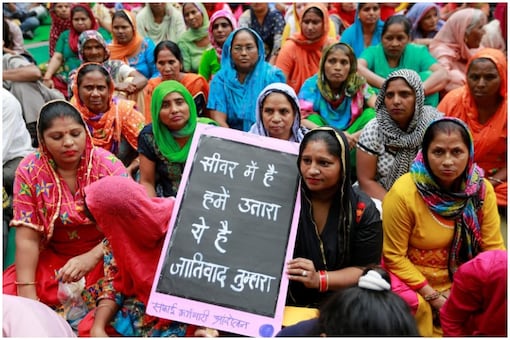Trigger warning: Gender, caste, and class-based violence
Through the potent weapon of religious traditions that have impacted social norms, women’s subjugation took on an especially harsh form in India. The legal support for a severe display of social stratification in which women and the lower castes have been subjugated to degrading living conditions is a distinguishing aspect of Hindu civilization. The structuring foundations of the Brahmanical social order are caste and gender hierarchy.
Also read: The Gaze Set On Female Labour Force Participation In India

Nur Yalman’s excellent essay on the castes of Ceylon and Malabar (1962) demonstrates that women’s sexuality, more than men’s, is a source of social concern. A major premise of Hindu social organisation, according to Yalman, is to build a closed structure in order to keep land, women, and ritual quality within it. The three are inextricably intertwined, and it’s hard to keep all three in check without meticulously organising female sexuality. Indeed, neither land nor ritual quality, i.e., caste purity, can be guaranteed without the strict protection of women, who are the foundation of the entire institution.
Through the potent weapon of religious traditions that have impacted social norms, women’s subjugation took on an especially harsh form in India. The legal support for a severe display of social stratification in which women and the lower castes have been subjugated to degrading living conditions is a distinguishing aspect of Hindu civilization. The structuring foundations of the Brahmanical social order are caste and gender hierarchy.
Men’s honour and respectability are protected and kept through their women, according to Yalman‘s writings. The onset of puberty thus signifies a highly ‘dangerous’ position and serves as the backdrop for large rites that emphasise the vital link between female purity and caste purity. Pre-puberty marriages for the upper castes, notably Brahmans, were advised very early on in order to strictly maintain the purity of castes. Yalman further says that caste blood is always bilateral, meaning that both parents pass on the ritual quality. As a result, both parents should ideally belong to the same caste.

Pre-puberty marriages for the upper castes, notably Brahmans, were advised very early on in order to strictly maintain the purity of castes. Yalman further says that caste blood is always bilateral, meaning that both parents pass on the ritual quality. As a result, both parents should ideally belong to the same caste.
Labour of love, unpaid labour and capitalism
As part of its Sustainable Development Goals, the United Nations took a step toward acknowledging housework in 2015, assessing the “percentage of time spent on unpaid domestic and care labour, by sex, age, and location.” Data taken from 90 countries covered in the UN’s most current development report last year, found a huge gap in how that work is distributed, with women “spending approximately three times as many hours in unpaid domestic and care work as males” between 2000 and 2016.
The stereotypical mainstream idea that women are born ‘nurturing’ and ‘caring’ and thus are supposed to be submissive and compliant to domestic labour without any acknowledgement is a result of age-old repression. According to Biological Determinism, the idea of ‘inherent’ characteristics accounts for male superiority and reflects the idea that men are naturally stronger, and rational and thus inherently smarter than women, and a person is born either as a male or a female-only, with defined masculine and feminine characteristics. This takes away the space of the LGBTQIA+ community.
This separation led to the demarcation between ‘public’ and ‘private’ spheres, and since men were supposed to be ‘inherently good leaders,’ only they could access the ‘public sphere.’

The stereotypical mainstream idea that women are born ‘nurturing’ and ‘caring’ and thus are supposed to be submissive and compliant to domestic labour without any acknowledgement is a result of age-old repression. According to Biological Determinism, the idea of ‘inherent’ characteristics accounts for male superiority and reflects the idea that men are naturally stronger, and rational and thus inherently smarter than women, and a person is born either as a male or a female-only, with defined masculine and feminine characteristics. This takes away the space of the LGBTQIA+ community.
They say, ‘Motherhood is a biological fact, fatherhood is a sociological fiction.’ which proves how the labour of women is ignored, repressed, and invisibilized. It is appalling how the idea of love is perpetuated in this oppressive practice of invisibilisation of the sexual division of labour where it is assumed that the work of women is naturally occurring and her dedicated and selfless demeanour is a natural obligated attribute.
“When you have an entire structure of unpaid labour buttressing the economy, then the sexual division of labour cannot be considered to be domestic or private: it is what keeps the economy going. If tomorrow every woman demanded to be paid for this work that she does, either the husband would have to pay her, or the employer would have to pay the husband. The economy would fall apart. This entire system functions on the assumption that women do housework for love. And is it only in tennis that ‘love’ means nothing?” writes Nivedita Menon in Seeing Like A Feminist.

Also read: Analysing Women’s Labour In India’s Gig Economy
‘Apart from domestic and care work, art is the industry with the most unpaid labour,’ argues Hito Steyerl, a contemporary artist and essayist. On practically every level and in almost every function, it survives on the time and energy of unpaid interns and self-exploiting actors. The mysterious black stuff that keeps the culture industry afloat is free labour and rampant exploitation.
Capitalism and the perpetuated exploitation of women
David W. Moore draws on an old contrast between capitalism’s ‘exploitation’ of paid labour and ‘appropriation’ of unpaid labour in his book ‘Capitalism in the Web of Life.’ The capitalist system appropriates numerous forms of unpaid labour and energy in order to maintain the hired workforce and allows economic exploitation. Capitalism appropriates women’s labour to give birth to, feed, clothes, and generally care for the waged workers. Moore borrows the term’ social reproduction’ from feminist critiques of capitalism and applies it to the natural world, asking, “Where does the ‘social’ moment of raising children end and the ‘biological’ moment begin?” It was justified as an expression of love when women undertook this labour as part of their marital duties.
‘Apart from domestic and care work, art is the industry with the most unpaid labour,’ argues Hito Steyerl, a contemporary artist and essayist. On practically every level and in almost every function, it survives on the time and energy of unpaid interns and self-exploiting actors. The mysterious black stuff that keeps the culture industry afloat is free labour and rampant exploitation.
Women’s employment has long been linked to notions about their inherent tendency to love, first for their husbands and children, then for the elderly within extended family groups. ‘They say it’s love,’ Silvia Federici wrote in her 1975 pamphlet Wages Against Housework. “We call it unpaid labour.’ Housework (and similarly, care work) has not been considered real work since it was culturally framed as a feminine gesture of love and nurture. The argument behind this is that love is its own reward—it satisfies a “natural” desire that is naturally joyful and hence does not require monetary compensation.

The troubling connection between caste, sexuality and labour
The generational institutionalised idea of caste-based labour and oppression is a privilege exclusively enjoyed by upper castes. In the movie Fandry, Jabya, a 10-year-old boy, refuses to pick up a pig from the sewer, which enrages the upper-caste man, who later reprimands the boy’s father, saying the boy has forgotten his’ duties.’ This only shows how institutionalised and oppressive the system is, which expects low-caste families to generationalise their labour and always acknowledge their position ‘below’ them. It is state-sanctioned social oppression as technological up-gradation, and sanitary facilities do not reach them.
The power hierarchy and power autonomy instill a superiority complex that allows upper classes and castes to oppress those in the lower levels of the hierarchy, who are pushed to marginalisation through absolutely scarce resources to avail education or basic socio-economic facilities. Thus the marginalised are habituated into a generational practice of menial servitude at the mercy of the upper caste hegemony. There is a multi-level intersected oppression here; the upper-caste woman is looked down upon if she wishes to work professionally outdoors and is relegated to queenly chores of the house, who in turn oppresses the marginalised lower-caste woman into performing menial chores of the house. The upper caste woman, who is oppressed by the heteronormative construct of marriage, exercises a social criterion to further oppress her similar gender.
Women’s employment has long been linked to notions about their inherent tendency to love, first for their husbands and children, then for the elderly within extended family groups. ‘They say it’s love,’ Silvia Federici wrote in her 1975 pamphlet Wages Against Housework. “We call it unpaid labour.’ Housework (and similarly, care work) has not been considered real work since it was culturally framed as a feminine gesture of love and nurture. The argument behind this is that love is its own reward—it satisfies a “natural” desire that is naturally joyful and hence does not require monetary compensation.
The disenfranchised living bodies of the Dalit women are in constant threat of social exclusions and state violence, and the raped and murdered bodies of Dalit women are ‘present’ in the silenced histories of indelible trauma and resistance within the Dalit community and beyond.
“There is a hungry, consuming voyeurism, characteristic of class society that makes one covet the grand and the unattainable. In contrast, for the bar girls and lower caste women, their very ‘availability’ renders them both vulnerable, ‘cheap’ and marks them out for abuse. Thus these lower caste women are stigmatized while those who exploit them are able to distance themselves from it.”
Gopal has a personal emphasis on the general understanding of female sexual labour translating into just prostitution. But she highlights how sexual labour has various bifurcations. She talks about Sundar Rajan’s idea of how the ban on bar dancers has highlighted the ‘unresolved issues in feminism.’ There are vague mentions of the relationships between feminists and the victimized, oppressed female, the concept of women’s work and the agency of women, and the expressions and transitions of women’s labours and sexuality in private and public domains.
Manual scavenging and the tanning industry
Women make up 95% – 98% of India’s 1.2 million manual scavengers. Despite their large numbers, very little research or government reporting has been done on these women. The practice of manual scavenging is passed down to young girls after marriage to work alongside their mothers-in-law, and any refusal to do so would result in their families and villages rejecting them. According to a 2014 study of 480 women, 85% of female scavengers are married. For cleaning a dry toilet during festivals, some women are paid as little as Rs 10 to Rs 20 a month plus a meal. In certain cases, these women are not compensated at all. Women who abandon the occupation, on the other hand, are stigmatised and excluded from community gatherings, and religious rites, and are kept at a distance. Even if these women stop scavenging for good, society will remember them (Bose 2019).
According to the Employees’ Provident Funds and Miscellaneous Provisions Act, 1952, and the Workmen’s Compensation Act, 1923, these women are denied minimum wages, emoluments, benefits, allowances, pensions, gratuity, and indemnity since they work in the unorganised sector. They are also ineligible for the six-week average daily income provided by Section 5 of the Maternity Benefit Act of 1961 to women employees after delivery. On the contrary, even during pregnancy, these women are seen carrying huge faecal baskets on their hips and heads. Because the phrase “employer” does not include independent families, the Sexual Harassment of Women at Workplace (Prevention, Prohibition and Redressal) Act of 2013 does not protect them against daily harassment.
Women make up 95% – 98% of India’s 1.2 million manual scavengers. Despite their large numbers, very little research or government reporting has been done on these women. The practice of manual scavenging is passed down to young girls after marriage to work alongside their mothers-in-law, and any refusal to do so would result in their families and villages rejecting them.
It is imperative to understand that caste-based labour further pushes women to the periphery where they cannot access freedom of their bodies and sexuality. They are paid less and recruited under severe conditions simply because the dogma that women need not be paid more or low castes do not need to be paid more, still persists quite blatantly.
Women are always at the receiving end of violence and are treated as second-class citizens in their own homes. The idea of preserving a family’s entire morality in the women and trying to justify hypermasculine chauvinism and patriarchal toxicity by molesting women shows how oppression functions majestically.
Satnamis, who identify as belonging to the Chamar community, say that “the upper castes would not touch us. They would never eat with us. But they were always ready to fornicate. For ‘doing it’ our women were not untouchable…Even after licking the private parts of Satnami women, they would not lose their purity.” Thus, to the upper caste ideology, the Dalit woman’s body is socially untouchable, but is sexually penetrable. The urban archivist’s orientalist gaze transforms the Dalit woman’s breasts into an “artefact” and a site of male violence. The male archivist, through his desire for preservation, exoticizes the Dalit woman’s body to the extent that the body gets converted into a thingness.
We justify paying domestic labourers so little because care work is a female-dominated industry, and we still think of women as biologically predisposed to love. As Hochschild says, first world employers believe immigrant women ‘to be especially gifted as caregivers: they are thought to embody the traditionally feminine qualities of nurturance, docility, and eagerness to please. The capacity for love, it seems, is cheap.
Ankita Kundu is pursuing Masters’s in Women’s Studies from the Tata Institute of Social Sciences, Mumbai. She writes poetry and paints in her free time. Her areas of interest include women’s rights, sexuality and socio-economic conditions, art and representation of women. She can be found on Instagram.
Featured Image Source: Shreya Tingal for Feminism In India






“If tomorrow every woman demanded to be paid for this work that she does, either the husband would have to pay her, or the employer would have to pay the husband. The economy would fall apart.”
1. Men provide women food, clothing, shelter, and all the necessities of life.
2. Most men are poor, and work all day in the scorching heat as rickshaw-pullers, labourers, fruit and vegetable sellers, vendors, carpenters, plumbers, electricians, sewage workers, coal miners, factory workers, construction workers, loggers, firefighters, police officers, tailors, barbers, milkmen, etc. Thousands of men suffer from severe dehydration and die from heat exhaustion. Thousands die from work related injuries.
3. Women work more hours at home just as men work more hours outside the home. Men on average live 10 years less than women because men are in the role of a provider. This is why the majority of suicides all over the world are men. Jobless men commit suicide, men with financial problems suffer heart attacks due to stress, men work the most dangerous jobs in the world and almost all workplace deaths are men, more men die in road accidents driving to and from work, most homeless are men, there is no awareness or funding for men’s health, etc. Is it surprising that men have lower life expectancy?
4. Majority of spending is done by women while majority of taxes are paid by men. Go to any shopping mall. Who is doing the shopping and whose money is being spent?
Not every woman wants to work outside the home. Many women are happy with light housework as most households now employ maids. It is not ‘unpaid’ work as men pay for women’s jewellery, vacations, food, clothes, mobile phones, watches, perfumes, purses, shoes, cosmetics, gifts, and the list goes on. On the other hand men work hard, receive inadequate pay, work under horrible bosses, suffer from workplace politics, and live under constant fear of losing their job.
Yes, a woman has to raise children just as a man has to pay for his child’s food, clothes, medicine, school fees, college education, and dozens of other things… just look at inflation today, look at the cost of education, a minor surgery on wife or child costs tens of thousands of rupees, if not lakhs.